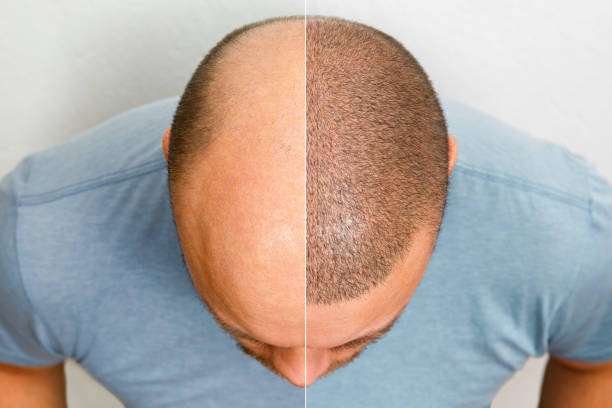Going Bald After Hair Transplant: What You Need to Know
Hair transplant surgery is a life-changing procedure for many individuals struggling with hair loss. However, one of the concerns that some people face after undergoing the procedure is the possibility of going bald after hair transplant. This topic is often discussed among people considering hair restoration, as they want to understand whether a hair transplant is a permanent solution or if hair loss will return.
In this article, we will explore the reasons why some individuals may experience hair loss after a hair transplant and what can be done to prevent it. Additionally, we will discuss how hair transplant for a big forehead can be a great option for individuals who want to improve their hairline and reduce the appearance of a larger forehead.
What is a Hair Transplant?
A hair transplant is a surgical procedure that involves relocating healthy hair follicles from a donor area (typically the back or sides of the scalp) to a thinning or balding area. This procedure aims to restore hair growth in areas that have experienced hair loss due to male pattern baldness or other factors. Hair transplant techniques have advanced significantly over the years, with two primary methods: Follicular Unit Extraction (FUE) and Follicular Unit Transplantation (FUT). Both techniques are effective at restoring hair, but the results can vary depending on individual factors.

Why Do Some People Go Bald After a Hair Transplant?
While hair transplants are highly effective for most individuals, it is possible to experience hair loss after the procedure. Several factors can contribute to this, and understanding them is essential for managing expectations and ensuring the best possible outcome.
1. Shock Loss
One of the most common reasons people experience hair thinning after a hair transplant is shock loss. Shock loss occurs when the newly transplanted hair follicles or the existing hair around the transplanted area shed temporarily due to the trauma caused by the procedure. This is a normal part of the healing process and usually resolves within a few months. In most cases, the transplanted hair will begin to regrow after this shedding phase.
2. Poor Donor Area Quality
Not all candidates for a hair transplant are ideal candidates. The quality and density of the donor hair play a crucial role in the success of the transplant. If the donor area has thinning or weak hair follicles, the transplant might not yield the desired results, and you could face hair thinning or balding after the procedure. For patients with limited donor hair, the options for a successful transplant may be limited.
3. Progression of Hair Loss
Another reason some individuals may go bald after a hair transplant is the ongoing progression of hair loss in areas that were not treated during the procedure. A hair transplant only addresses the areas that were transplanted, and it does not prevent further hair loss in untreated areas. If you continue to lose hair after the transplant, it can create an uneven appearance, where the transplanted area looks full, but the surrounding areas show signs of thinning or balding.
4. Poor Aftercare
Proper aftercare is crucial to the success of a hair transplant. If the patient does not follow the post-surgery care instructions provided by the surgeon, it can lead to complications, including infections or poor healing. These issues can negatively impact the results of the transplant and lead to hair loss in the treated areas. It’s essential to avoid strenuous physical activities, protect the scalp from sunlight, and maintain a clean environment for the transplanted area.
5. Underlying Medical Conditions
Certain medical conditions can interfere with the success of a hair transplant. Conditions such as alopecia areata, thyroid disorders, and scalp infections may cause hair loss after the procedure. Before undergoing a hair transplant, it’s important to have a thorough consultation with your surgeon to identify any potential medical issues that could affect the results.
6. Age and Genetics
As with natural hair growth, the success of a hair transplant can also be influenced by age and genetics. If you’re genetically predisposed to hair loss, it’s possible that new bald spots could appear in areas where hair was not transplanted. Age also plays a role, as hair loss tends to become more aggressive over time.
Hair Transplant for Big Forehead
Many men and women consider hair transplants not only to combat baldness but also to address cosmetic concerns such as a big forehead. A hair transplant for a big forehead is a common reason individuals seek hair restoration. The procedure involves transplanting hair follicles to the hairline to lower the forehead and achieve a more balanced, youthful appearance.
By relocating hair follicles to the front of the scalp, a hair transplant can create a more natural hairline that reduces the prominence of a large forehead. The results can be striking, improving facial aesthetics and boosting self-confidence.
A skilled surgeon will carefully design the new hairline, taking into consideration the patient’s facial features, the size of the forehead, and natural hair growth patterns. For individuals with a high forehead, this type of hair transplant can be transformative, offering a more youthful and harmonious appearance.
How to Prevent Going Bald After a Hair Transplant
While going bald after a hair transplant is possible, there are several steps you can take to prevent it and ensure long-lasting results:
1. Consult with an Experienced Surgeon
Choosing a skilled and experienced surgeon is the first step toward successful hair restoration. A good surgeon will assess your individual case, consider factors such as your hair type and quality of donor hair, and recommend the best treatment options for your needs. An experienced surgeon will also be able to advise you on how to care for your hair and scalp post-transplant.
2. Consider Medications
In addition to the hair transplant itself, medications like Minoxidil and Finasteride can help prevent further hair loss and maintain the results of the transplant. These medications can slow the progression of hair thinning in areas that were not treated during the procedure, preventing new bald spots from forming.
3. Follow Aftercare Instructions
To ensure the success of your hair transplant and reduce the chances of going bald after the procedure, it’s essential to follow the aftercare instructions provided by your surgeon. This includes taking care of your scalp, avoiding excessive sun exposure, and avoiding activities that could disrupt the transplanted follicles.
4. Regular Check-Ups
After the procedure, it’s important to schedule regular follow-up appointments with your surgeon to monitor your progress. These check-ups can help identify any potential issues early on and ensure that you’re on track for the best possible outcome.
5. Maintain a Healthy Lifestyle
A healthy lifestyle plays a significant role in the overall health of your hair. Eating a balanced diet rich in vitamins and minerals, managing stress, and avoiding harmful habits like smoking can help maintain the strength and vitality of both transplanted and natural hair.
Conclusion
Going bald after a hair transplant is a concern for some individuals, but it is not inevitable. Understanding the factors that contribute to hair loss after a transplant, such as shock loss, donor area quality, and ongoing hair loss progression, can help you take the right steps to achieve the best results.
For those considering a hair transplant for a big forehead, this procedure can offer a significant improvement in both the hairline and overall appearance, giving you a more youthful and confident look. By choosing an experienced surgeon, following aftercare instructions, and considering additional treatments, you can maximize the success of your hair transplant and prevent future hair loss.
If you’re concerned about going bald after hair transplant surgery, consult with a professional to understand the best options tailored to your needs, ensuring you achieve the full, natural hairline you desire.


1 Comment